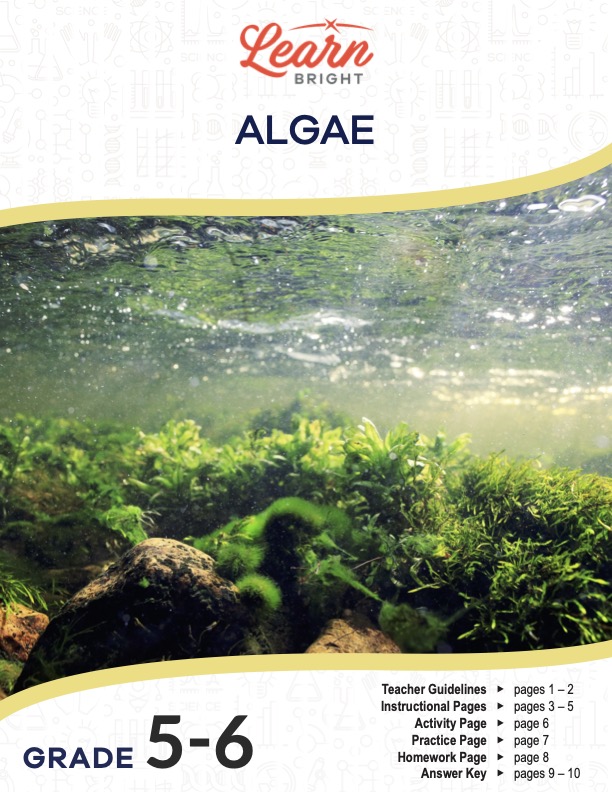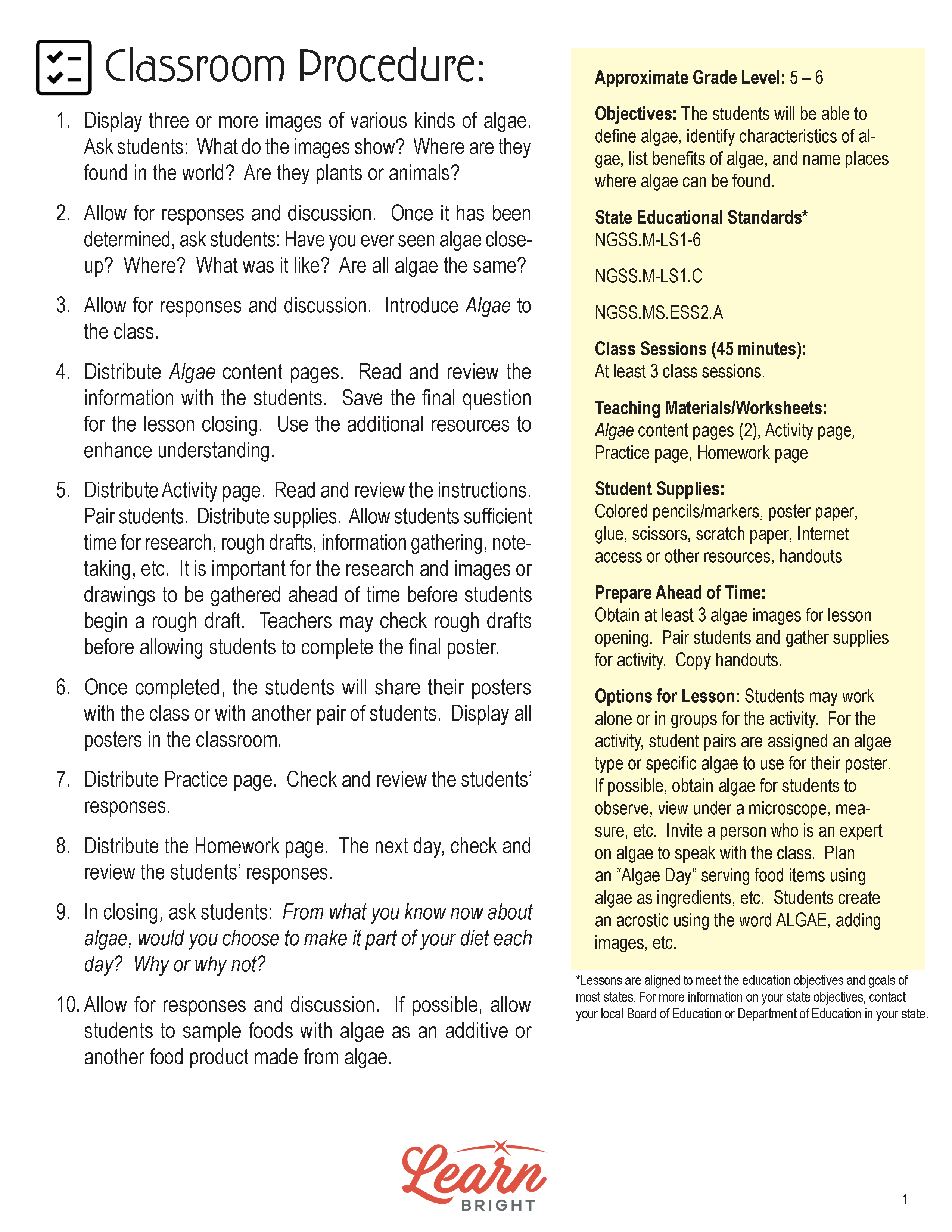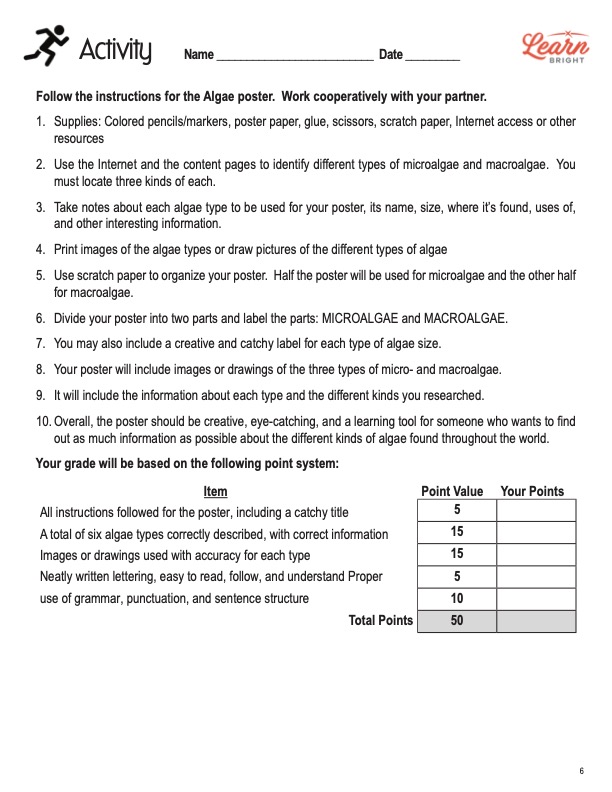Description
What our Algae lesson plan includes
Lesson Objectives and Overview: Algae teaches students about this unique substance, including the different types and their benefits. Students will discover where they can find it all over the world. They will learn about the traits of various algae and be able to identify them according to those traits. This lesson is for students in 5th grade and 6th grade.
Classroom Procedure
Every lesson plan provides you with a classroom procedure page that outlines a step-by-step guide to follow. You do not have to follow the guide exactly. The guide helps you organize the lesson and details when to hand out worksheets. It also lists information in the yellow box that you might find useful. You will find the lesson objectives, state standards, and number of class sessions the lesson should take to complete in this area. In addition, it describes the supplies you will need as well as what and how you need to prepare beforehand. The supplies you will need for this lesson include colored pencils or markers, poster paper, glue, scissors, and scratch paper. You will also need access to the internet or other resources. Before giving the lesson, make sure to gather three images of algae for the lesson opening as well.
Options for Lesson
This section lists a number of suggestions for additional activities or ideas you can incorporate into the lesson. One such idea is to assign student pairs a specific type of algae to research for the activity poster. Another option is to obtain actual algae for students to observe and view under a microscope. You could also invite an algae expert to come speak to the class. Check out the “Options for Lesson” section for even more ideas.
Teacher Notes
The paragraph on the Teacher Notes pages provides some additional guidance for you. It mentions that it is more important for students to understand the benefits, types, and sources of algae than to memorize the complex terms. The goal is simply for them to learn things about algae that they didn’t know before. You can use the blank lines to write down any extra ideas or thoughts you have before you administer the lesson to your students.
ALGAE LESSON PLAN CONTENT PAGES
Background Information
The Algae lesson plan contains three pages of content. Students will first learn what algae actually is, who studies it, and where it comes from. Contrary to what many people think, it is not a plant, even though they have many of the same traits. Algae are living things that, like plants, make their food from sunlight using the process of photosynthesis. Most of these organisms store energy as some form of complex sugar. Phycologists are scientists who study algae, or phycology. The most common sources of algae include seas, oceans, rivers, lakes, ponds, and even aquariums.
There are only two main types of algae that all the different species fall into: macroalgae and microalgae. The lesson points out to students that they are most likely familiar with macroalgae because of seaweed, the most common type of algae. It explains that a good way to think of seaweed is as a big plant or weed that lives in the ocean. The correct classification for algae is as a protist, not a plant. Protists are organisms that do not fall into the categories of animals, plants, fungi, bacteria, and so on.
Microalgae, on the other hand, is another term to describe phytoplankton. The prefix “micro” means very small. Therefore, an easy way to think of these is as small plants that live in the oceans, rivers, ponds, etc. No matter the type, these organisms have been around for more than 2 billion years. Still, scientists discover new species all the time! They have discovered about 37,000 species so far, but they estimate that there are still around 30,000 waiting for discovery.
Comparing Algae to Plants
The lesson provides a diagram that shows a plant next to a seaweed to help students see how the two differ. A seaweed has blades, which resemble a plant’s leaves fairly closely. Instead of a stem, seaweeds have a stipe. And rather than roots, they have holdfasts.
Holdfasts provide support to the seaweed. Unlike the roots of plants, however, they do not provide any nutrients. Instead, the entire seaweed absorbs nutrients as it sits in the water. Not all seaweed have a stipe. If it does have a stipe, that is the part that sends nutrients to the holdfast. The blade is the leaf-like structure. A collection of blades is a frond. Seaweeds also have air-filled bladders that help keep the stipe and fronts floating. These are called floats. Floats contain gas and help lift the algae to the surface of the water to help them receive sunlight. The stipe serves this purpose in algae that don’t contain floats.
Brown, Green, and Red
Students will then learn about a few different types of algae: brown, green, and red. Another word for brown algae is kelp. There are roughly 1,800 species of kelp, most of which are marine. These live in colder water sources. These are also the most complex type of marine algae. They are often attached to rocky coasts in temperate climate zones.
Green algae most often lives in fresh water and attaches to rocks or wood under the water. It can appear as scum atop stagnant water. Finally, there are nearly 7,000 species of red algae. Around 5% of these occur in freshwater environments. These species mostly live in warmer areas and often at great depths. They also attach to other shore plants. Another word for this group is rhodophyta.
Phytoplankton can be green or blue-green algae that floats in the upper part of the ocean. They contain chlorophyll and require sunlight to live and grow. Some live in fresh water (these are called pond algae), some are bacteria, and some are protists. Most of them are single-celled organisms.
The final content page contains several more vocabulary words and explains some additional information about algae. Students will learn some interesting facts. For example, microscopic algae are actually the source of much of the earth’s oxygen. The red algae nori is a very popular food in Japan. Several other species provide a great source of food as well.
Key Terms
Here is a list of the vocabulary words students will learn in this lesson plan:
- Phycologist: a person who studies algae (phycology)
- Phycology: the study of algae
- Algae: a type of plant-like living organism that lives in water
- Carbohydrate: a complex sugar
- Holdfast: the part of a seaweed similar to a plant root that provides support
- Stipe: the stem-like part of a seaweed that sends nutrients to the holdfast
- Blade: a part of a seaweed that looks like a leaf
- Frond: a group of blades on a seaweed
- Float: an air-filled bladder that contains gas to help lift algae to the surface of the water and thus receive sunlight
- Phytoplankton: a microscopic marine algae
- Diatoms: microalgae that are spherical, elliptical, triangular, or star-shaped
- Flagella: short tails that help dinoflagellates move through water
ALGAE LESSON PLAN WORKSHEETS
The Algae lesson plan includes three worksheets. Each one will help students better grasp the content and reinforce what they learned. You can look at the classroom procedure guidelines to know when to hand out each worksheet to your students. There are answer keys with the correct answers in red for both the practice and homework worksheets. If you choose to administer the lesson pages to your students via PDF, you will need to save a new file that omits these pages. Otherwise, you can simply print out the applicable pages and keep these as reference for yourself when grading assignments.
MICRO AND MACRO ACTIVITY WORKSHEET
Students will work with a partner for the activity. However, you can have them work in small groups or by themselves if you prefer. Students will gather images and information from the internet and other sources on different types of microalgae and macroalgae. They must come up with three kinds for each type. After they gather the materials they want to use, they will create a poster, using half the board for microalgae and the other half for macroalgae. They can use scratch paper to create a rough draft before they begin working on the poster itself. Use the rubric at the bottom of the worksheet to grade students’ posters.
QUESTION AND ANSWER PRACTICE WORKSHEET
The practice worksheet requires students to answer 12 questions using what they learned from the content pages. If they cannot find the answer, they should infer based on the information from the lesson.
ALGAE HOMEWORK ASSIGNMENT
For the homework assignment, students will first match definitions to the terms in a word bank. There is a total of 15 definitions and terms to match in this section. Then, students will look at 10 descriptions and decide if they relate to brown (B), green (G), or red algae.
Worksheet Answer Keys
The last pages of the PDF are answer keys for the practice and homework worksheets. Both provide the correct answers in red to make it easy to compare with students’ responses. If you choose to administer the lesson pages to your students via PDF, you will need to save a new file that omits these pages. Otherwise, you can simply print out the applicable pages and keep these as reference for yourself when grading assignments.











